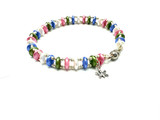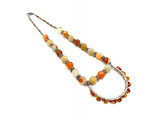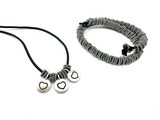Nickel-Free Metals Information
What is "Nickel Free"?
The term "nickel free" can be confusing since jewelry marked nickel free is still allowed to contain a very small amount of nickel ... but it is such a tiny amount that it takes extremely sensitive instruments to measure it.
The European Union's (EU) Nickel Directive limits the amount of nickel that may be released onto the skin from jewelry and other products. This type of measurement is distinct from measuring the percentage of nickel that exists in an alloy's composition. The Nickel Directive's migration limits are as follows:
- 0.2 micrograms per cm per week for post assemblies inserted into pierced ears and other pierced parts of the human body
- 0.5 micrograms per cm per week for other products intended to come into direct and prolonged contact with the skin.
The UK has also adopted the EU Nickel Directive as its standard. If you have customers in the UK or EU - or if you want to start marketing your jewelry in those countries - you'll want to comply with the EU Nickel Directive.
There is not yet a US standard for allowable amounts of nickel in jewelry, but if/when there is one, it will probably be similar to the European standard.
What is "Hypoallergenic"?
The term hypoallergenic means "below the normal level" of allergenic, so technically, anything that less than 50% of the population is allergic to, could be called hypoallergenic. The term was coined by the cosmetics industry in the 1950's, and became a popular marketing term for jewelry soon afterwards. Sometimes "nickel free" and "hypoallergenic" are confused as being synonymous, but this is not true. Hypoallergenic does not mean nickel free, nor does it have a legal or medical definition for use in jewelry. You're better off using the specific materials linked below rather than looking for materials labeled with the vague term hypoallergenic.
Is Surgical Stainless Steel "Nickel Free"?
No, it is not. Most surgical stainless steel contains 8 - 10% nickel. This definitely does not meet the EU Nickel Directive. Nickel is added to stainless steel, to harden the steel and to prevent discoloration and corrosion. Surgical stainless steel is corrosion-resistant, so it is frequently used for surgical instruments, but it is not a great material for people with metal allergies to wear as jewelry. More information about stainless steel and surgical stainless steel.
Jewelry Components that Meet the EU Nickel Directive
Since there is no US nickel standard, and since alloys vary, a good way to find items that are very low in nickel is to search for components that meet the EU Nickel Directive. Here are several options offered by Rings & Things:
To narrow down the options, you can use the search box at the top of your screen to search for similar terms such as "gold charm nickel directive" or "nickel directive earring post"
Nickel-Free Metals & Components
Another option is to avoid base-metal alloys entirely, and instead use elemental and precious metals in your custom jewelry. The following options are all nickel free (by definition, they meet the EU Nickel Directive):
Sterling silver is an alloy, but does not contain any nickel, so is wearable by most segments of the population. Sterling is sometimes stamped .925, because it's made of at least 92.5% pure silver. Typically the remaining 7.5% consists of copper. Tarnish-resistant Argentium sterling silver is 1.2% germanium, 6.3% copper and 92.5% silver. More info about sterling silver.
Niobium is an element and is therefore not mixed with any other metals. It is naturally nickel free and very resistant to corrosion. Niobium comes in a wide variety of intense anodized (non-plated) colors.
Titanium is also an element and thus naturally nickel free. Like niobium, it's highly resistant to corrosion. It's also a very strong metal. Because of this, titanium is frequently used in medical implants and is a good choice for earring findings. The natural color of Titanium is a silver-gray color, similar to stainless steel, but sometimes a bit grayer. It mixes well with the color of sterling silver, but definitely is not a color match.
14kt yellow gold is commonly made of the following materials: 58% elemental (pure) gold, 25% elemental silver, and 17% elemental copper. Gold can be alloyed with other metals, too, to achieve different colors (such as rose gold) or different karats (10kt, 18kt, etc.). Be aware that white gold commonly contains nickel (added for both color and strength).
Our Bead Blog
-
Simply Springy 2-Hole Bracelet
Apr 28th 2025Designed by: Guest Designer Deb Floros Suggested Supplies 1 #61-840-50-01 Beadalon Cord, WildFire,
-
Exotic Statement Necklace
Apr 28th 2025Designed by: Guest Designer Deb Floros Suggested Supplies 1 #88-400-003-5 58x50mm Pewter Connector,
-
Rubber Tubing Necklace and Memory Wire Bracelet Set
Mar 21st 2025Designed by: Guest Designer Deb Floros Suggested Supplies 1 #61-622-02 2mm Rubber Cord, Bulk, for J



